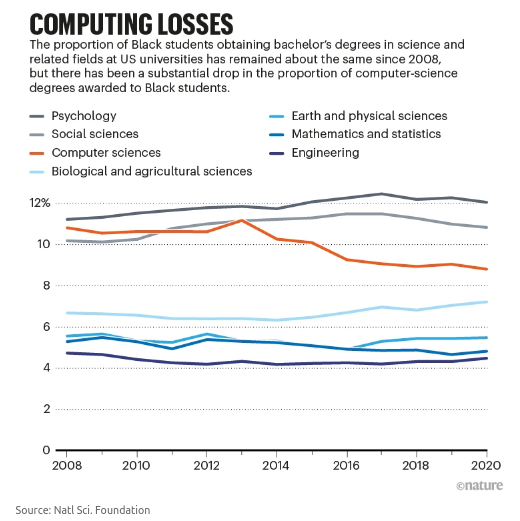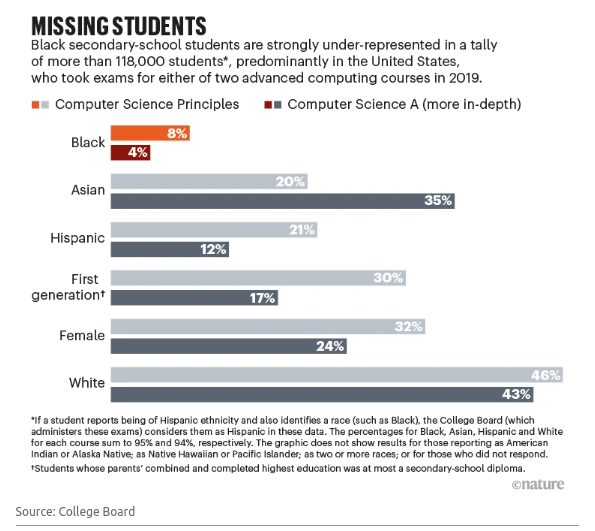Technology
Computer science has a racism problem: these researchers want to fix it
By Melba Newsome ||
10 mins ||
25 April, 2024
Black and Hispanic people face huge hurdles at technology companies and in computer-science education in the United States, with far-reaching consequences for science and all of society.
Juan Gilbert felt alone as he pursued a PhD in computer science in the 1990s. It was a familiar sense that had followed him throughout his university years, as a student from modest means and the first of his family to pursue higher education.
But there was something else that weighed on him during his doctoral training at the Ohio State University in Columbus, one of the largest academic institutions in the United States. Despite the size of the university, there were no people who looked like him in the computer-science graduate programme or among the department’s faculty members.
“I didn’t see another Black person in computer science until more than a decade after high school,” says Gilbert.
He contemplated leaving the field entirely until a Black professor at another university encouraged him to find another programme instead.
Gilbert transferred to the University of Cincinnati in Ohio, where he built a community of other Black PhD students. But his ‘a-ha’ moment came when he joined the computer-science faculty at Auburn University in Alabama, where there was one other Black faculty member and two Black PhD students in the department. It clarified something for him he feels should have been obvious: all across the country, there were Black PhDs just like him who were struggling with isolation just like him, enduring microaggressions just like him and fighting the urge to quit, just like him.
With that realization, he pledged to help create a more supportive and inclusive computer-science environment for Black students, and has continued that work as chair of the Department of Computer & Information Science & Engineering at the University of Florida in Gainesville. He thinks that vision is why the university ranks top in terms of the number of computer science PhDs awarded to Black students, and why it boasts the largest proportion of Black computer-science faculty members at any predominantly white institution in the United States.
Why diversity matters
There are diversity gaps in computer science and in science, technology, engineering and mathematics (STEM) subjects in many countries. The problem is particularly acute in the United States, which spends much more than any other country on research and development and is home to many of the largest technology companies. Despite being a global leader in computer science, the United States has long struggled to increase diversity in this area.
Computer occupations make up one of the fastest-growing employment sectors in the United States, and the US Bureau of Labor Statistics projects that the number of jobs in this area will increase three times faster than the average — and faster than many other fields in STEM. But Black, Latino and Indigenous people remain under-represented in computing jobs. Black and Hispanic people make up almost 13% and 18% of the US workforce, but they hold only 7% and 8%, respectively, of the jobs in computing. (The US government considers ‘Hispanic or Latino’ an ethnicity and that people of Hispanic or Latino origin may be of any race.)
The diversity gap is growing at universities. For bachelor’s degrees, the primary degree granted by US universities, the proportion of computer-science degrees going to Black students has dropped from more than 11% in 2013 to less than 9% in 2020 (see ‘Computing losses’).

That’s a problem, says Gilbert, because computer science is now so fundamental to everything.
“Computing is in health, transportation, education, finance, you name it — computing is there,” he says. “And recent reports have found that, when you have a lack of diversity, computing implementations can have a bias that disproportionately affects certain [marginalized] people in a very dramatic way.”
That belief also drives Shaundra Daily, an electrical and computing engineer at Duke University in Durham, North Carolina. “When you leave people out of the thought, design, development and policy — and all the pieces that are important to make sure that we have equitable technologies — you end up with technology either not helping or effectively harming minoritized populations,” she says.
Algorithms are perhaps the clearest example. They are supposed to make predictions or complex decisions about everyday life without the taint of human emotion or prejudice, say computer-science specialists.
“All data science is political,” says James Mickens, a computer scientist at Harvard University in Cambridge, Massachusetts. “A lot of engineers and non-engineers think that math, science and engineering are somehow detached from values or, because we’re dealing with numbers, the decisions are morally neutral. That’s just not true.”
Based on who builds algorithms, how they’re developed and how they’re used, they can and sometimes do replicate the very biases that they were designed to overcome, says Mickens.
Beyond the issue of algorithmic bias, businesses are finding financial reasons for increasing diversity along gender, racial and ethnic lines. “The most diverse companies are now more likely than ever to outperform non-diverse companies on profitability”, according to a 2020 report by the global management-consulting firm McKinsey and Company1. Diverse teams are also more productive and creative, and bring different perspectives, says Mickens. Famously, non-diverse teams gave us seat belts that are not designed for pregnant people; facial recognition software that doesn’t recognize or misidentifies people of colour; and autonomous vehicles that cannot recognize darker-skinned pedestrians.
In the past few years, however, commitments and pledges from the tech industry on diversity have amounted to very little, according to a 2022 report2 from the non-profit Kapor Center and the NAACP, a civil-rights organization headquartered in Baltimore, Maryland. The current share of Black talent in technical roles has increased just 0.6% since 2018, it notes.
Freeman Hrabowski, former president of the University of Maryland, Baltimore County (UMBC) in Baltimore, gained an international reputation for success in preparing students from under-represented backgrounds to enter STEM fields. Of all US universities, UMBC awarded the most undergraduate degrees to Black students who went on to earn doctorates in this area.
In 2011, Hrabowski chaired a panel for the National Academies of Sciences, Engineering, and Medicine, and at that time only 2.2% of the PhDs in the natural sciences and engineering went to Black people. Ten years later, he says, that number is 2.3%. “With all the initiatives, we still are not at 3%. We have failed to move the needle,” says Hrabowski.
These much-vaunted initiatives have also failed to diversify the computing and technology work sector. Hrabowski spoke to about 2,000 employees this year at a major tech company, where the few employees of colour were doing the kinds of menial job that their parents would have done 50 years earlier. “For the most part, they were on the bottom rung. They were not professionals. I kept it real when I spoke to them and repeated what we all know now, which is that there are far too few people of colour in those companies.”
Hrabowski, Daily and Gilbert are among the many educators and computer scientists working to change the trajectory at universities and tech companies for Black people and other under-represented minority groups. They are realistic about the challenges but think that change is crucial — and possible.
Where to begin
Hrabowski says structural racism in academia hinders the nation’s ability to deal with some of its biggest challenges. To remedy or even mediate tech’s diversity problem, he says, academics and stakeholders must first acknowledge and then confront bias in all aspects, from university admissions to recruitment, hiring and promotion.
When it comes to succeeding in computer science, the tech talent pipeline starts early — and so do the disparities in access and outcomes. Many students from under-represented groups face structural and social barriers in both exposure and access to computer science from the beginning of their educational voyage (see ‘Missing students’). The Kapor–NAACP study reports that almost one-quarter of Black students lack access to computers or reliable high-speed Internet at home, and that just 75% of Black students go to schools that offer foundational computer-science courses. These kinds of courses, says Mickens, are essential to improving the number who graduate with STEM degrees.

others
Featured Post
Tech SIM Swap Attacks: Analysis and Protective Mea...
Tech SIM Swap Attacks: Analysis and Protective Measures...
11 September, 2025
10 mins
Recent Post
Computer science has a racism problem: these resea...
Black and Hispanic people face huge hurdles at technology companies an...
How to Generate Astonishing Animations with ChatGP...
How to Generate Astonishing Animations with ChatGPT
The Web’s Next Transition
The web is made up of technologies that got their start over 25 years ...
Fundamentals of React Hooks
Hooks have been really gaining a lot of popularity from the first day ...
4 Easy Steps to Structure Highly Unstructured Big ...
4 Easy Steps to Structure Highly Unstructured Big Data, via Automated ...
Comparison of Top 6 Python NLP Libraries
Comparison of Top 6 Python NLP Libraries
Type Checking with TypeScript in React Native Navi...
📱 In the realm of mobile app development with React Native, ensuring ...
React 19 new features
React version 19 introduces a slew of groundbreaking features aimed at...
14 amazing macOS tips & tricks to power up your pr...
The mysteriOS Mac-hines keep having more hidden features the more you ...
React Native App Development Guide
DWIN, founded in 2015, has swiftly established itself as a leader in c...
Guide to Set Up Push Notifications in React Native...
1. Create a New React Native Project (if not already created)
Core Web Vitals: The Technical (Dark) Side of SEO
What You’ll Learn
Top 20 mobile apps which nobody knows about…
In the vast ocean of mobile applications, some remarkable gems often g...
How much does mobile app development cost
The cost of developing a mobile application can vary depending on seve...
Software Testing: Principles and Stages Simplified...
In the world of software development, testing is not just a phase but ...
Core Web Vitals: The Technical (Dark) Side of SEO
What You’ll Learn
Tech SIM Swap Attacks: Analysis and Protective Mea...
Tech SIM Swap Attacks: Analysis and Protective Measures
10 Hottest New Apps for You to Get Ahead in Septem...
Here we are again, in a tribute to the amazing stream of ideas that pr...